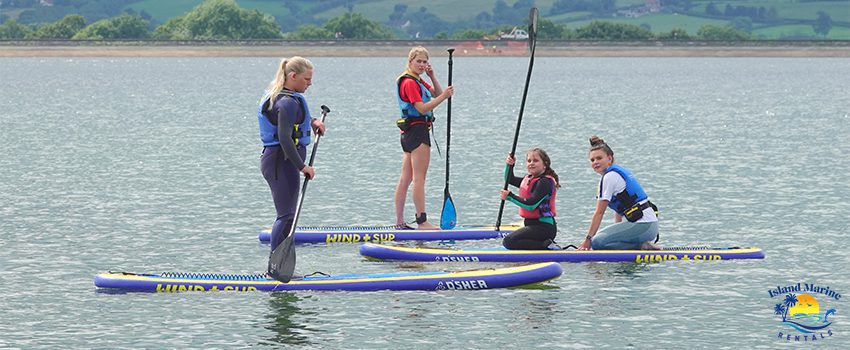A skilled stand up paddle boarder glides seamlessly and gracefully across the water. If you are new to the hobby, however, the opposite might be true. SUP takes a lot of practice and patience to master. You have to work through the zigzags and falls before being able to stand becomes a breeze.
Don’t worry. In this guide, you’ll be taught some paddle boarding basics. By starting your journey with these tips, you can conserve your energy efficiently while improving your SUP skills.
Without further ado, here are some helpful ideas on how to paddle board properly.
How To Hold a Paddle Board Paddle
Having the right paddle length is crucial for an easy experience. A paddle that’s too long may be difficult to carry, while one that’s too short may need you to compromise your posture.
There are also adjustable- or fixed-length paddles, the former being more novice-friendly than the latter. Usually, the way individuals paddle would determine whether they are newbies or pros.
To help you avoid common mistakes when holding a paddle board paddle, here are some tips you can apply:
1. Hold the Blade at the Right Angle
The blade should be angled slightly forward from the shaft, towards the board’s nose. When using the paddle, the blade should always be oriented this way, unless you are performing expert strokes. When in this position, the power face — or the side of the blade that is aimed back at you — allows you to push the water and propel the paddle board forward.
2. Practice Proper Hand Position
Another way to properly hold a SUP paddle is to tightly grip the shaft with one hand and the other on the T-grip. Make sure you don’t overdo it. Instead, gently grasp the shaft and T-grip. In addition, avoid having your hands too close to each other.
Proper Paddle Board Strokes
Riding the waves on a paddle board might seem tiresome or difficult at first. But, as you continue to practice and get more comfortable on the water, you can paddle more efficiently and refine your paddle boarding techniques. This would allow you to move towards a certain direction or turn while practicing proper paddle board strokes.
Here are five essential SUP strokes to try:
Forward Stroke
This is a basic stroke that every paddle boarder should know. To do this, keep your arms nearly straight while twisting your torso as you paddle. If you’re moving towards the right, keep your right hand on the paddle shaft while your left hand stays on top of the grip. Do the opposite when paddling left. Plant the paddle as forward as you can, then, with your top hand, push the paddle grip all the way down the surface before bringing it back up and aligned with your ankle.
Reverse Stroke
This basic paddle board stroke is usually used for slowing down, turning, and stopping. Like with the forward stroke, keep your arms straight and twist your torso. Instead of pulling the blade forward, you should reach behind you and plant the paddle close to your board’s tail. While doing so, make sure that the blade is placed all the way underneath the water’s surface.
Sweep Stroke
The sweep stroke is useful when trying to turn your board while either moving or standing still. Unlike the first two strokes, this stroke requires you to bend your knees more and lower your arms a bit so the T-grip would be below shoulder height.
When paddling on the right, rotate your shoulders so your right shoulder is forward. Submerge the entire blade perpendicularly to your board. Afterwards, sweep the paddle away using a big turning motion from your board’s nose to its tail. Do this by gripping with your legs and hips as you rotate your torso. Doing this stroke on the right side of the board allows you to turn to the left and vice versa.
Draw Stroke
The draw stroke allows you to move your paddle board to the side when attempting to pull over at a dock or changing your course.
When planting the blade, it should be parallel to your paddle board, and the power face facing the board. After submerging the blade, pull it towards your direction to move the board on the side.
Take the blade out of the water by swinging it towards either the board’s nose or tail. Repeat the process.
Cross Bow Stroke
This paddle board stroke allows tight, efficient turns without needing to change your stance on the board. It’s useful for performing quick course adjustments while in motion.
To do this stroke when turning to the left, follow these simple steps:
- Stand in a neutral stance on the center of your board and rotate your torso towards the left side as you paddle on your right.
- Bring the paddle across your board’s nose, and submerge the entire blade in the water on the left side of your board.
- Rotate your torso to the right with the power face facing the right to bring the paddle towards your board’s nose.
- If you hit your paddle board’s nose while trying to bring the paddle around, lift it out of the water before putting it back on the other side. Rotate the paddle board around in an arcing motion.
Rent a Paddle Board Today
SUP requires a lot of skill to master; start your learning journey by renting a paddle board today.
Island Marine Rentals offers the best stand up paddle board and boat rental service in Madeira Beach, FL. When in search for the biggest and best boards in the industry, we offer Liquid Shredder SUP boards that possess outstanding stability on water. Call us today to learn more about our paddle board rentals.


